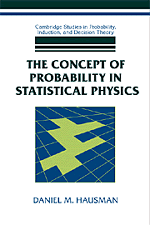Book contents
- Frontmatter
- Contents
- Introduction
- Chapter 1 The Neo-Laplacian Approach to Statistical Mechanics
- Chapter 2 Subjectivism and the Ergodic Approach
- Chapter 3 The Haar Measure
- Chapter 4 Measure and Topology in Statistical Mechanics
- Chapter 5 Three Solutions
- Appendix I Mathematical Preliminaries
- Appendix II On the Foundations of Probability
- Appendix III Probability in Nonequilibrium Statistical Mechanics
- Author Index
- Subject Index
Chapter 2 - Subjectivism and the Ergodic Approach
Published online by Cambridge University Press: 12 November 2009
- Frontmatter
- Contents
- Introduction
- Chapter 1 The Neo-Laplacian Approach to Statistical Mechanics
- Chapter 2 Subjectivism and the Ergodic Approach
- Chapter 3 The Haar Measure
- Chapter 4 Measure and Topology in Statistical Mechanics
- Chapter 5 Three Solutions
- Appendix I Mathematical Preliminaries
- Appendix II On the Foundations of Probability
- Appendix III Probability in Nonequilibrium Statistical Mechanics
- Author Index
- Subject Index
Summary
THE ATOMISTIC CONCEPTION IN LIGHT OF THE RESEARCH ON THE BROWNIAN MOTION
In 1909, William Ostwald, formerly one of the most vocal opponents of atomism, admitted that, “recently we have come into possession of experimental proof of the discrete or granular nature of matter, for which the atomic hypothesis had vainly sought for centuries, even millennia.” The proof consisted of the “isolation and counting of gas ions” and “the agreement of Brownian movements with the predictions of the kinetic hypothesis.” Ostwald commended J. J. Thomson and J. Perrin for the former and later parts of the experimental work, respectively.
The interest in atomism and the willingness to consider adopting it as a new theory of matter was not confined to the community of physicists. Due to the efforts of Perrin, the topic was discussed and debated in a wide range of semipopular publications and lectures. The result was a fairly wide-ranging acceptance of atomism, a change of world view that deserves to be called a conceptual revolution. On first blush, the willingness of the educated world to reverse its opinion on the issue of atomism seems rather inexplicable. Only nine years earlier, Boltzmann was practically the only physicist on the continent who espoused the atomistic conception of matter. One should remember, though, that the climate of opinion at the time, especially on the continent, favored new and extreme views. Indeed, both Mach's radical phenomenalism and Perrin's strange new world of “real” atoms exerted considerable fascination at the time.
- Type
- Chapter
- Information
- The Concept of Probability in Statistical Physics , pp. 64 - 133Publisher: Cambridge University PressPrint publication year: 1999

